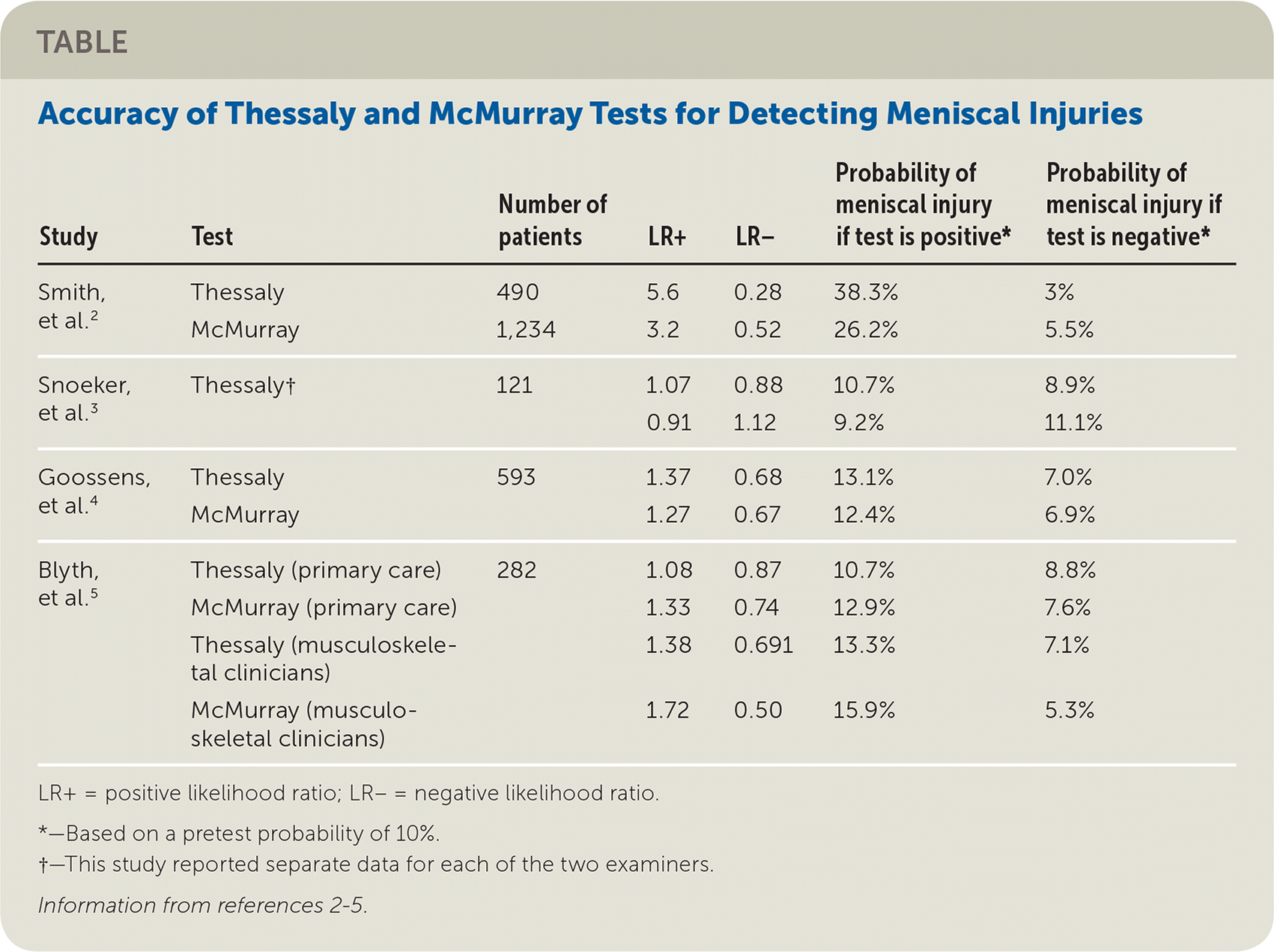
Am Fam Physician. 2019;100(4):200-201
Original Article: Knee Pain in Adults and Adolescents: The Initial Evaluation
Issue Date: November 1, 2018
See additional reader comments at: https://www.aafp.org/afp/2018/1101/p576.html
To the Editor: In this article on knee pain in adults, the authors contend that the Thessaly test is an accurate test for diagnosing meniscal injury. A 2012 article in American Family Physician1 reached similar conclusions regarding the Thessaly test. This was a reasonable conclusion based on the evidence available at the time; however, the patients in the studies cited in that article were diagnosed and treated at referral centers with high prevalence rates of meniscal injuries. Since 2012, additional evidence has suggested that the Thessaly test is not as accurate as initially reported.
A systematic review and meta-analysis of studies available through the end of 20142 concluded that the Thessaly test has similar, and perhaps slightly superior, accuracy when compared to the McMurray and joint line tenderness tests. However, the authors concluded that none of the three tests are particularly accurate for diagnosing meniscal injuries.
More recent studies have produced results that make us further question the accuracy of the Thessaly test (see accompanying table2–5).

| Study | Test | Number of patients | LR+ | LR− | Probability of meniscal injury if test is positive* | Probability of meniscal injury if test is negative* |
|---|---|---|---|---|---|---|
| Smith, et al.2 | Thessaly | 490 | 5.6 | 0.28 | 38.3% | 3% |
| McMurray | 1,234 | 3.2 | 0.52 | 26.2% | 5.5% | |
| Snoeker, et al.3 | Thessaly† | 121 | 1.07 | 0.88 | 10.7% | 8.9% |
| 0.91 | 1.12 | 9.2% | 11.1% | |||
| Goossens, et al.4 | Thessaly | 593 | 1.37 | 0.68 | 13.1% | 7.0% |
| McMurray | 1.27 | 0.67 | 12.4% | 6.9% | ||
| Blyth, et al.5 | Thessaly (primary care) | 282 | 1.08 | 0.87 | 10.7% | 8.8% |
| McMurray (primary care) | 1.33 | 0.74 | 12.9% | 7.6% | ||
| Thessaly (musculoskeletal clinicians) | 1.38 | 0.691 | 13.3% | 7.1% | ||
| McMurray (musculoskeletal clinicians) | 1.72 | 0.50 | 15.9% | 5.3% |
The evidence summarized in the table indicates that the initial results of high accuracy of the Thessaly test are not replicated in later studies. The outlying results reported by Grover1 may be explained in part by nonblinded examiners as well as a test population skewed toward high pretest probability of meniscal injury. We conclude, contrary to assertions in the reference article, that the Thessaly test is nonsuperior to the McMurray test in the diagnosis of meniscal injuries. Moreover, there is little evidence to support using either of these maneuvers in the evaluation of knee pain, particularly in the primary care population.
In Reply: Thank you for your careful review and consideration of our article. We welcome the opportunity for additional discussion of physical examination maneuvers in the initial evaluation of knee pain.
Physical examination techniques remain a challenge to accurately study. Patient selection, timing from injury, previous patient functional level, examination setting, provider skills/training, and concomitant injuries are all potential confounders.
Our assessment is based on the volume of papers suggestive of Thessaly being superior. Many additional references were ultimately not included in our article because of reference limitations. The article you cited supports our conclusion of higher sensitivity and specificity for Thessaly.1 Added to this are articles by Karachalios, et al., yielding 92% sensitivity and 96% specificity for Thessaly2; and Harrison, et al., yielding 90% sensitivity and 97% specificity.3
Our interpretation of the data surrounding Thessaly continues to support its use (strength of recommendation taxonomy rating C), but we also recommend it as a patient-controlled examination technique. This subtle difference can increase a patient's comfort level and should not be overlooked.
We thank you for highlighting the challenges inherent in physical examination technique research as well as the ongoing debate about examinations in general.
The opinions and assertions contained herein are the private views of the authors and are not to be construed as official or as reflecting the views of the Department of Defense, the U.S. Air Force Medical Service, the Uniformed Services University of the Health Sciences, or the U.S. Air Force at large.
